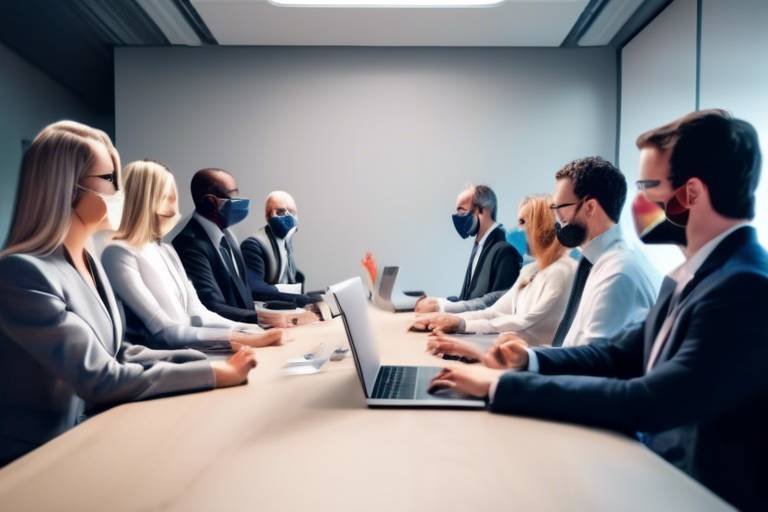Personal Safety - The Effects of Alcohol and Drugs
In today's world, the conversation around personal safety increasingly intertwines with the effects of alcohol and drugs. Whether it’s a night out with friends or a casual gathering at home, the choices we make regarding substance use can have profound implications on our safety and well-being. Have you ever thought about how that one drink might cloud your judgment or how a party drug could alter your perception? The reality is that both alcohol and drugs can lead to risky behaviors, making it essential to understand their impacts. In this article, we will delve into how these substances affect our decision-making, behavior, and overall safety, while also exploring strategies for prevention and harm reduction.
When it comes to alcohol, its influence on our decision-making process is nothing short of significant. Imagine stepping into a social situation where the atmosphere is charged with excitement, laughter, and, of course, drinks flowing freely. As you sip that cocktail, your inhibitions begin to fade, and suddenly, what seemed like a good idea in the moment might not be so wise after all. Alcohol consumption can lead to impaired judgment, causing individuals to engage in behaviors they might typically avoid. Think about it: would you normally accept a ride from a stranger or engage in risky activities? Probably not, but under the influence, these choices can seem harmless. This alteration in decision-making can jeopardize personal safety, putting individuals at risk of accidents, violence, or even legal issues.
Much like alcohol, the use of drugs can dramatically alter behavior and perception. Each substance has its own set of effects, often leading to impaired motor skills and increased aggression. Picture a scenario where someone under the influence of a stimulant might feel invincible, leading to reckless behaviors such as driving at high speeds or engaging in physical confrontations. It's not just the user who is at risk; those around them may also find themselves in dangerous situations. The effects of drugs can vary widely, and understanding these differences is crucial for recognizing potential hazards.
Different categories of drugs can have unique impacts on the mind and body, complicating the landscape of personal safety. Here’s a brief overview of some common types:
| Type of Drug | Effects | Safety Risks |
|---|---|---|
| Stimulants | Increased energy, alertness | Risky behaviors, health emergencies |
| Depressants | Relaxation, sedation | Impaired coordination, accidents |
| Hallucinogens | Altered perceptions, hallucinations | Dangerous decision-making, unpredictable behavior |
Stimulants like cocaine and methamphetamine can provide a rush of energy, but they come with a hefty price. The heightened energy can lead to impulsive and dangerous behaviors, increasing the likelihood of health emergencies. For instance, users may engage in extreme physical activities or take unnecessary risks, all while feeling invincible. This false sense of security can quickly spiral into situations that threaten personal safety.
On the other hand, depressants such as alcohol and benzodiazepines can make individuals feel relaxed and at ease. However, this relaxation can come at a cost. Impaired coordination and judgment can make individuals more susceptible to accidents and unsafe situations. For example, someone might attempt to drive home after a few drinks, unaware of their diminished capabilities. The consequences can be dire, not just for the individual but for others on the road as well.
The long-term effects of chronic alcohol and drug use can lead to severe health issues, including addiction and an increased vulnerability to dangerous situations. Over time, the brain becomes conditioned to rely on these substances, often leading to a cycle that becomes difficult to break. As personal safety diminishes, individuals may find themselves in perilous environments or engaging in activities that put their lives and the lives of others at risk.
Fortunately, there are effective strategies to mitigate the risks associated with alcohol and drug use. By implementing educational programs and harm reduction practices, we can promote safer environments for individuals and communities alike. Have you ever considered how knowledge can empower you to make better choices? Education is key in raising awareness about the dangers of substance use, equipping individuals with the tools they need to navigate social situations safely.
Community-based education programs can play a pivotal role in raising awareness about the dangers of substance use. These initiatives provide individuals with the knowledge necessary to make informed decisions, fostering a culture of safety and responsibility. By understanding the risks associated with alcohol and drugs, individuals can better protect themselves and others.
Access to support systems, such as counseling and rehabilitation services, is crucial for individuals struggling with substance abuse. These resources enhance personal safety and recovery opportunities, providing a lifeline for those in need. Remember, seeking help is a sign of strength, not weakness.
- How does alcohol affect my judgment? Alcohol impairs cognitive functions, leading to poor decision-making and risky behaviors.
- What are the dangers of mixing drugs? Mixing drugs can amplify their effects, leading to unpredictable and potentially life-threatening situations.
- How can I stay safe while drinking? Set limits for yourself, stay aware of your surroundings, and never drink and drive.
- What should I do if I see someone in danger due to substance use? Call for help, ensure their safety, and if possible, intervene in a non-confrontational manner.

The Impact of Alcohol on Decision Making
Alcohol consumption significantly alters judgment and decision-making abilities, leading to risky behaviors that can jeopardize personal safety and well-being in social situations. When individuals drink, they often experience a sense of euphoria and lowered inhibitions, which can create a false sense of security. It's like putting on a pair of rose-tinted glasses that obscure the reality of the situation. For instance, a person may feel invincible after a few drinks, believing they can handle risky activities such as driving or engaging in confrontations. However, the reality is quite different.
Studies have shown that even small amounts of alcohol can impair cognitive functions. A recent study revealed that individuals with a blood alcohol concentration (BAC) of just 0.05% exhibited reduced attention and impaired ability to process information. This impairment can lead to poor decision-making, where individuals may choose to engage in behaviors that they would typically avoid. For example, someone might decide to take a shortcut through a dangerous neighborhood or accept a ride from a stranger after a night out. These choices can have dire consequences.
Moreover, alcohol affects the brain's prefrontal cortex, which is responsible for executive functions such as planning, impulse control, and risk assessment. When this part of the brain is compromised, individuals may struggle to weigh the consequences of their actions. This is why many people find themselves in precarious situations after drinking. They might think, "What could possibly go wrong?" without fully understanding the potential dangers lurking around them.
It's essential to recognize the patterns of behavior that emerge with alcohol consumption. For instance, people are more likely to engage in risky activities when under the influence, such as:
- Driving while intoxicated
- Participating in physical altercations
- Engaging in unprotected sex
- Experimenting with drugs
Each of these behaviors carries significant risks not only for the individual but also for others. The ripple effect of one person's poor decision can lead to a cascade of negative outcomes, impacting friends, family, and even strangers. It's a sobering thought, isn't it?
To put this into perspective, let's consider a simple table that illustrates how alcohol affects different aspects of decision-making:
| Aspect of Decision Making | Impact of Alcohol |
|---|---|
| Judgment | Impaired; leads to risky choices |
| Impulse Control | Reduced; increased likelihood of spontaneous actions |
| Risk Assessment | Distorted; underestimation of potential dangers |
| Emotional Regulation | Altered; can lead to aggression or over-euphoria |
In conclusion, the impact of alcohol on decision-making is profound and often dangerous. Recognizing these effects can help individuals make more informed choices about their drinking habits and understand the potential consequences of their actions. It's crucial to approach alcohol consumption with a sense of responsibility and awareness, ensuring that personal safety and the safety of others remain a priority.
Q: How does alcohol affect my ability to make decisions?
A: Alcohol impairs judgment and decision-making, leading to risky behaviors and poor choices.
Q: What are some common risky behaviors associated with drinking?
A: Common risky behaviors include driving under the influence, engaging in physical fights, and having unprotected sex.
Q: Can I mitigate the risks associated with alcohol consumption?
A: Yes, strategies such as setting limits on drinking, using designated drivers, and staying aware of your surroundings can help reduce risks.

Drug Use and Its Influence on Behavior
When it comes to the world of substance use, drugs are notorious for their ability to alter behavior and perception dramatically. The moment someone decides to experiment with drugs, a cascade of changes begins to unfold. This isn't just about feeling high or euphoric; it's about how these substances can completely reshape a person's actions and interactions with the world around them. Have you ever noticed how someone under the influence might behave in ways that are completely out of character? That's the power of drugs at play.
Different drugs have varying effects, and understanding these can be crucial for recognizing the potential dangers. For instance, stimulants can lead to an overwhelming sense of energy, but they can also push individuals toward risky behaviors, such as reckless driving or aggressive confrontations. On the other hand, depressants, which include substances like alcohol and benzodiazepines, can slow down the central nervous system, impairing coordination and judgment. This impairment can lead to unfortunate accidents or dangerous situations that could have been easily avoided.
Moreover, the influence of drugs isn't limited to just the user. It can create a ripple effect that impacts everyone in the vicinity. For example, a person under the influence of hallucinogens might misinterpret their surroundings, leading to unpredictable behavior that could endanger themselves or others. Imagine being at a party where someone suddenly believes they can fly because of a hallucinogenic experience. The potential for harm escalates not only for the individual but for anyone nearby.
To illustrate this further, let’s look at a table that summarizes the different types of drugs and their behavioral effects:
| Type of Drug | Common Examples | Behavioral Effects |
|---|---|---|
| Stimulants | Cocaine, Methamphetamine | Increased energy, heightened alertness, potential aggression |
| Depressants | Alcohol, Benzodiazepines | Slowed reaction times, impaired judgment, increased risk of accidents |
| Hallucinogens | LSD, Psilocybin | Altered perception, unpredictable behavior, potential for dangerous situations |
It’s essential to recognize that these substances can lead to a cycle of behavior that not only affects the user but also poses risks to friends, family, and even strangers. The social implications of drug use are profound and can lead to a breakdown in relationships, increased violence, and a greater likelihood of engaging in criminal activities.
Ultimately, understanding how drugs influence behavior is a critical step in addressing the broader issues of personal safety. By being aware of these effects, individuals can make more informed choices and communities can develop better support systems to mitigate the risks associated with drug use. So, the next time you find yourself in a situation involving drugs, ask yourself: What’s at stake? How can I ensure safety for myself and those around me?
- What are the most common drugs that affect behavior? Stimulants, depressants, and hallucinogens are among the most common categories that significantly alter behavior.
- Can drug use lead to long-term behavioral changes? Yes, chronic drug use can lead to lasting changes in behavior, including increased aggression and impaired decision-making.
- How can I help someone struggling with drug use? Encouraging them to seek professional help and providing support through counseling and rehabilitation resources can be effective.

Types of Drugs and Their Effects
When we talk about drugs, it's essential to understand that not all substances are created equal. Each type of drug interacts with our body and mind in unique ways, leading to different effects that can significantly impact personal safety. These effects can range from mild alterations in perception to severe impairments that put the user and others at risk. The primary categories of drugs include stimulants, depressants, and hallucinogens, each with its own distinct effects and potential dangers.
Stimulants, such as cocaine and methamphetamine, are known for their ability to increase energy and alertness. However, this heightened state can come at a cost. Users may feel invincible, leading to reckless behavior that jeopardizes their safety. For instance, the rush of adrenaline combined with impaired judgment can result in dangerous situations, such as driving under the influence or engaging in aggressive confrontations. The table below summarizes some common stimulants and their effects:
| Drug | Effects | Risks |
|---|---|---|
| Cocaine | Increased energy, euphoria | Heart problems, paranoia |
| Methamphetamine | Heightened focus, decreased appetite | Severe addiction, violent behavior |
On the flip side, we have depressants, which include substances like alcohol and benzodiazepines. These drugs work by slowing down the central nervous system, leading to relaxation and sedation. While this may sound appealing, the consequences can be dire. Impaired coordination and judgment can make individuals more susceptible to accidents, such as falls or drowning, especially in social settings where alcohol is prevalent. The effects of depressants can be deceptive; what starts as a fun night out can quickly spiral into a dangerous situation. Here’s a brief overview of some common depressants:
- Alcohol: Often consumed socially, it can lead to severe impairment and risky behaviors.
- Benzodiazepines: Prescribed for anxiety, these can cause drowsiness and confusion, increasing the risk of accidents.
Lastly, we have hallucinogens, such as LSD and psilocybin mushrooms. These drugs alter perception, mood, and cognitive processes. Users may experience vivid visual and auditory hallucinations, which can lead to unpredictable behavior. The lack of control over one's thoughts and actions can pose significant risks, especially in unfamiliar environments. The potential for a 'bad trip' can result in anxiety, panic, and dangerous actions that could harm both the user and those around them.
In summary, understanding the types of drugs and their effects is crucial for recognizing the risks associated with substance use. Each category presents unique challenges that can compromise personal safety. Whether it’s the reckless abandon of stimulants, the deceptive calm of depressants, or the unpredictable nature of hallucinogens, being informed is the first step toward making safer choices.
What are the most common types of drugs that affect personal safety?
The most common types include stimulants (like cocaine and methamphetamine), depressants (such as alcohol and benzodiazepines), and hallucinogens (like LSD and psilocybin). Each type has unique effects that can compromise personal safety.
How can I protect myself from the risks of drug use?
Educating yourself about the effects of drugs, avoiding situations where substance use is prevalent, and seeking support if you or someone you know is struggling with substance abuse can help mitigate risks.
Are there resources available for those struggling with substance abuse?
Yes, there are numerous resources available, including counseling services, support groups, and rehabilitation programs that can provide assistance and promote recovery.

Stimulants and Their Risks
When we think of stimulants, names like cocaine and methamphetamine often come to mind. These substances may create an illusion of heightened energy and alertness, but the reality is much darker. The use of stimulants can lead to a rollercoaster of effects that not only compromise personal safety but can also spiral into dangerous situations. Imagine feeling invincible, only to find that your judgment is clouded, and your perception of reality is warped. This is the deceptive nature of stimulants.
Stimulants work by increasing the levels of certain neurotransmitters in the brain, primarily dopamine, which is responsible for feelings of pleasure and reward. While this might sound appealing, the consequences can be severe. Users often engage in risk-taking behaviors that they would typically avoid. For instance, someone under the influence might drive recklessly, engage in unsafe sexual practices, or even confrontational behavior that could lead to physical altercations.
Moreover, the physical effects of stimulants can be alarming. Increased heart rate, elevated blood pressure, and hyperthermia are just a few of the risks associated with stimulant use. These physiological changes can lead to serious health emergencies, such as heart attacks or strokes, particularly in individuals with pre-existing health conditions. It's like revving up a car engine without considering whether the vehicle can handle the speed; eventually, something is bound to break down.
Understanding the risks associated with stimulants is crucial. Here’s a quick overview of some common stimulants and their potential dangers:
| Stimulant | Effects | Risks |
|---|---|---|
| Cocaine | Increased energy, euphoria | Heart problems, addiction, paranoia |
| Methamphetamine | Heightened alertness, decreased appetite | Severe dental issues, extreme weight loss, violent behavior |
| Prescription Stimulants (e.g., Adderall) | Improved focus, increased energy | Dependency, anxiety, cardiovascular issues |
It's essential to recognize that the allure of stimulants can lead to a cycle of misuse and dependency. For many, the initial high is just the beginning of a tumultuous journey marked by escalating use and increasingly risky behavior. The temporary boost in energy can quickly turn into a downward spiral, impacting not just the user but also those around them. Think of it as a firework: it may light up the sky for a moment, but it can also cause a lot of damage if not handled with care.
In conclusion, while stimulants may offer a fleeting sense of euphoria or energy, the associated risks can be profound and life-altering. It's crucial to approach these substances with caution and awareness. Remember, personal safety should always come first, and understanding the potential dangers of stimulants is a vital step in protecting oneself and others.
- What are stimulants? Stimulants are substances that increase activity in the brain, leading to heightened alertness and energy.
- What are the common effects of stimulants? Common effects include increased heart rate, elevated mood, and decreased appetite.
- What are the risks associated with stimulant use? Risks include addiction, heart problems, and engaging in dangerous behaviors.
- How can I stay safe if I choose to use stimulants? Educate yourself about the substances, know your limits, and always prioritize your safety and the safety of those around you.

Depressants and Dangers
When we talk about depressants, we’re diving into a category of substances that can have profound effects on the body and mind. These include well-known drugs like alcohol and benzodiazepines, which are often prescribed for anxiety or insomnia. While they may seem harmless when used responsibly, the truth is that depressants can lead to a slippery slope of dangerous consequences. Imagine a scenario where a person consumes a few drinks to unwind after a long day. Initially, they might feel relaxed and sociable, but as the night progresses, their coordination and judgment begin to falter. This is where the real danger lies.
One of the most alarming aspects of depressant use is how it can impair motor skills. Picture trying to navigate a crowded street after consuming a significant amount of alcohol. Your reflexes slow down, and decisions that would normally seem clear become muddled. This not only puts the user at risk of accidents but also endangers others around them. For instance, a person under the influence may decide to drive home, believing they are in control, when in reality, their ability to react to sudden changes is severely compromised.
Moreover, the combination of depressants with other substances, such as opioids or stimulants, can create a cocktail of risks. This interaction can lead to unpredictable effects, heightening the chances of overdose or severe health complications. A table summarizing the common depressants and their potential dangers can provide a clearer picture:
| Depressant | Potential Dangers |
|---|---|
| Alcohol | Impaired judgment, increased risk of accidents, addiction |
| Benzodiazepines | Memory loss, dependence, respiratory issues when mixed with other drugs |
| Barbiturates | High risk of overdose, severe withdrawal symptoms |
In social settings, the dangers of depressants can escalate quickly. Friends might encourage each other to drink more, leading to a collective disregard for safety. The environment becomes a breeding ground for risky behaviors, such as engaging in fights, making poor choices about sexual consent, or even wandering off alone in unsafe areas. It’s crucial to remember that while depressants may initially provide a sense of relief or escape, they can also create a false sense of security that clouds judgment.
Ultimately, understanding the dangers associated with depressants is essential for personal safety. It’s not just about the immediate effects; it’s about recognizing how these substances can alter our perceptions and behaviors in ways that might lead to unforeseen consequences. Being aware of these risks can empower individuals to make more informed decisions, whether they’re at a party, a bar, or simply enjoying a night out with friends. So, the next time you’re tempted to indulge, ask yourself: is it truly worth the potential risks?
- What are the most common depressants? Alcohol, benzodiazepines, and barbiturates are among the most commonly used depressants.
- How do depressants affect the body? They slow down brain activity, impair coordination, and can lead to addiction and withdrawal symptoms.
- Can mixing depressants with other substances be dangerous? Yes, combining depressants with other drugs can increase the risk of overdose and severe health complications.
- What should I do if someone is overdosing on depressants? Call emergency services immediately and provide as much information as possible about the substances involved.

Long-Term Consequences of Substance Abuse
Substance abuse is not just a fleeting phase; it can lead to a series of long-term consequences that can drastically alter an individual's life. When someone indulges in alcohol or drugs, the immediate effects might seem harmless or even pleasurable, but the repercussions can be severe and far-reaching. One of the most significant issues is the development of addiction, which can transform the brain's chemistry, making it nearly impossible for individuals to control their cravings. This addiction can lead to a vicious cycle where the user feels compelled to consume more substances, further endangering their personal safety and well-being.
Moreover, chronic substance abuse can result in a myriad of health complications. For instance, long-term alcohol consumption can lead to liver disease, while prolonged drug use can impair cognitive functions and lead to mental health disorders such as anxiety and depression. These health issues not only affect the individual but can also strain relationships with family and friends, creating a ripple effect of emotional distress and isolation.
Another alarming consequence is the increased vulnerability to dangerous situations. Individuals struggling with substance abuse often find themselves in precarious environments, whether it's engaging in risky behaviors, such as driving under the influence, or associating with unsafe individuals. These choices can lead to accidents, legal troubles, or even violent encounters. The reality is that the longer someone abuses substances, the more likely they are to face situations that jeopardize their safety.
Furthermore, the impact of substance abuse extends beyond personal health and safety. It can lead to financial instability as individuals may prioritize their addiction over responsibilities, leading to job loss or financial ruin. This instability can create a cycle of stress and desperation, pushing individuals further into substance use as a means of coping.
In summary, the long-term consequences of substance abuse are profound and multifaceted. They encompass health issues, addiction, vulnerability to dangerous situations, and financial instability. It is crucial to recognize these risks and seek help early on to mitigate the potential for a lifetime of challenges.
- What are the signs of substance abuse? Signs can include changes in behavior, neglecting responsibilities, and withdrawal from social activities.
- How can I help someone struggling with addiction? Encourage them to seek professional help, offer support, and educate yourself about addiction.
- Are there effective treatments for substance abuse? Yes, treatments such as therapy, support groups, and rehabilitation programs can be very effective.

Strategies for Reducing Risks
When it comes to navigating the treacherous waters of alcohol and drug use, having a solid strategy for reducing risks is absolutely essential. The reality is that many individuals may not fully grasp the potential dangers that come with substance use, which is why implementing effective strategies can make a world of difference. One of the most impactful ways to foster safer environments is through education and awareness programs. These programs serve as a beacon of knowledge, illuminating the risks associated with substance use and providing individuals with the tools they need to make informed decisions.
Imagine walking into a room filled with information—posters, brochures, workshops, and discussions that delve into the effects of alcohol and drugs. Community-based education programs can be tailored to address the specific needs of different demographics, ensuring that the messages resonate with the audience. For instance, younger individuals might benefit from interactive sessions that engage them in conversations about peer pressure and the consequences of substance use. In contrast, adults may appreciate workshops focusing on the long-term effects of addiction and how to support loved ones who struggle with substance abuse.
Another vital component of reducing risks is establishing robust support systems and resources. Access to counseling and rehabilitation services can be a game-changer for individuals grappling with substance abuse. It’s like having a safety net—when people know that help is available, they are more likely to seek assistance. Support groups can provide a sense of community and shared experience, making individuals feel less isolated in their struggles. These resources can also empower individuals with coping strategies and skills to manage their challenges effectively.
Furthermore, it’s crucial to create an environment that encourages open dialogue about substance use. This can be achieved through community initiatives, where individuals are encouraged to share their experiences and insights. By fostering a culture of honesty and support, we can dismantle the stigma surrounding addiction and promote a more understanding society. In doing so, we not only enhance personal safety but also contribute to the well-being of our communities as a whole.
In addition to educational programs and support systems, implementing harm reduction practices can significantly mitigate the risks associated with substance use. Harm reduction is all about minimizing the negative consequences of drug and alcohol use without necessarily requiring abstinence. This approach acknowledges that while some individuals may choose to use substances, there are ways to do so more safely. For example, providing access to clean needles, safe consumption spaces, and overdose prevention education can save lives. It’s a pragmatic approach that recognizes the complexities of substance use and aims to protect individuals and their communities.
Ultimately, the journey towards reducing risks associated with alcohol and drug use is multifaceted. It requires a combination of education, support, and harm reduction strategies. By working together as a community, we can create a safer environment for everyone. So, let’s take the first step by promoting awareness and ensuring that individuals have the resources they need to make safer choices.
- What are some signs of substance abuse? Common signs include changes in behavior, neglecting responsibilities, and physical health issues.
- How can I find support for someone struggling with addiction? Look for local support groups, counseling services, or rehabilitation centers that specialize in addiction recovery.
- What is harm reduction, and how does it work? Harm reduction focuses on minimizing the negative effects of drug use through practical strategies, rather than insisting on abstinence.
- Are there any community programs for education on substance use? Yes, many communities offer programs that educate individuals about the risks of substance use and provide resources for prevention.

Education and Awareness Programs
Education and awareness programs play a crucial role in combating the risks associated with alcohol and drug use. These initiatives are designed to inform individuals about the dangers of substance misuse and provide them with the tools they need to make informed decisions. Imagine walking into a room filled with knowledge, where every corner offers insights into how substances can alter our lives. This is the essence of effective education programs.
One of the key components of these programs is the emphasis on real-life scenarios. By presenting case studies and testimonials from those who have experienced the negative effects of substance abuse firsthand, participants can connect emotionally with the material. This connection often leads to a deeper understanding of the consequences of risky behaviors. For instance, a program might share a story about a young adult whose life spiraled out of control due to alcohol, illustrating the potential dangers in a relatable way.
Moreover, these programs often incorporate interactive elements to engage participants actively. Activities such as role-playing and group discussions can foster an environment where individuals feel comfortable sharing their thoughts and experiences. This not only enhances learning but also builds a sense of community among attendees, promoting peer support. In fact, studies have shown that individuals are more likely to retain information when they actively participate in the learning process.
To further enhance the effectiveness of these programs, many organizations utilize multimedia resources. Videos, infographics, and social media campaigns can reach a broader audience and cater to different learning styles. For example, a short video that outlines the effects of binge drinking can be more impactful than a lengthy lecture. By diversifying the methods of education, these programs can ensure that the message resonates with a wider demographic.
Additionally, community-based initiatives often collaborate with local schools, health organizations, and law enforcement to create a comprehensive approach to education. This collaboration helps to ensure that the message is consistent and reaches individuals in various settings. For instance, workshops held in schools can educate students about the dangers of drug use, while community events can provide resources for parents and guardians. Such partnerships create a unified front against substance abuse, reinforcing the idea that everyone has a role to play in promoting safety.
In summary, education and awareness programs are essential in fostering a safe environment where individuals can learn about the risks of alcohol and drug use. By employing engaging methods, utilizing multimedia resources, and collaborating with various community sectors, these programs can effectively equip individuals with the knowledge and skills needed to make safer choices. Remember, the more informed we are, the better we can protect ourselves and our loved ones from the perils of substance misuse.
- What types of education programs are available? There are various programs, including school-based workshops, community seminars, and online courses focused on substance abuse prevention.
- How can I get involved in local awareness programs? You can contact local health departments or non-profit organizations to find out about upcoming events and volunteer opportunities.
- Are these programs effective? Yes, numerous studies indicate that well-structured education programs significantly reduce substance abuse rates among participants.

Support Systems and Resources
When it comes to navigating the turbulent waters of substance abuse, having a solid support system can be a game changer. Imagine trying to swim against a strong current without any help—it's exhausting and often leads to drowning. In the same way, individuals grappling with addiction need robust resources and support to help them regain their footing and ensure their personal safety. Support systems can come in various forms, including family, friends, and community organizations, all of which play a pivotal role in recovery.
One of the most effective ways to foster a supportive environment is through community-based programs. These programs provide not only education but also a sense of belonging and understanding among peers who have faced similar struggles. They often include group therapy sessions, workshops, and activities designed to promote sober living. The camaraderie built in these settings can be incredibly empowering, reminding individuals that they are not alone in their journey.
In addition to community programs, professional counseling is essential for those dealing with substance abuse. Trained professionals can offer tailored strategies to cope with addiction, addressing the underlying psychological issues that often accompany substance use. This one-on-one support can help individuals develop healthier coping mechanisms, making them less likely to revert to substance use in times of stress.
Furthermore, many organizations provide rehabilitation services that offer a structured environment for recovery. These facilities can range from inpatient programs, where individuals receive round-the-clock care, to outpatient programs that allow for more flexibility. The key is to find a program that suits the individual's needs, ensuring that they receive the appropriate level of support while working towards sobriety.
Access to resources is critical, and many communities have established hotlines and support groups that individuals can reach out to at any time. These resources often provide immediate assistance and can guide individuals toward long-term recovery options. It’s vital for those struggling to know that help is just a phone call away, ready to offer support and guidance.
To give you a clearer picture of the types of support available, here’s a brief overview:
| Type of Support | Description |
|---|---|
| Community Programs | Group activities and workshops that promote sobriety and provide peer support. |
| Counseling Services | Professional guidance to address psychological issues related to substance use. |
| Rehabilitation Facilities | Structured environments for intensive recovery support. |
| Hotlines | 24/7 assistance for immediate help and resource guidance. |
Ultimately, the journey to recovery is not one that should be taken alone. By leveraging the available support systems and resources, individuals can significantly enhance their chances of overcoming addiction and improving their personal safety. It’s all about creating a network of support that empowers individuals to make positive changes in their lives.
- What types of support systems are available for individuals struggling with substance abuse? There are various support systems including community programs, counseling services, rehabilitation facilities, and hotlines.
- How can community programs help in recovery? Community programs provide peer support, education, and activities that promote sober living, creating a sense of belonging among individuals facing similar challenges.
- Why is professional counseling important? Professional counseling addresses underlying psychological issues and helps individuals develop healthier coping strategies, which are crucial for long-term recovery.
- Are there resources available for immediate help? Yes, many communities have hotlines that provide 24/7 assistance and can guide individuals toward necessary resources.
Frequently Asked Questions
- What are the effects of alcohol on personal safety?
Alcohol can significantly impair judgment and decision-making abilities. When individuals consume alcohol, they may engage in risky behaviors, such as driving under the influence or getting into unsafe situations. This can jeopardize not only their own safety but also the safety of others around them.
- How do drugs influence behavior and personal safety?
Various drugs can alter perception and behavior drastically. For example, stimulants can lead to increased energy but also heighten the risk of dangerous actions. On the other hand, depressants may impair motor skills and judgment, making individuals more susceptible to accidents and unsafe environments.
- What types of drugs pose the most significant risks?
Different categories of drugs carry unique risks. Stimulants like cocaine can lead to aggressive behavior and health emergencies, while depressants, including alcohol and benzodiazepines, can severely impair coordination. Hallucinogens can distort reality, leading to poor decision-making, which can endanger personal safety.
- What are the long-term consequences of substance abuse?
Chronic use of alcohol and drugs can lead to severe health issues, including addiction and mental health disorders. These long-term effects can make individuals more vulnerable to dangerous situations and impact their overall personal safety.
- How can individuals reduce the risks associated with alcohol and drug use?
Implementing effective strategies such as education and harm reduction practices can significantly mitigate risks. Community-based education programs raise awareness about the dangers of substance use, while support systems like counseling can provide essential help for those struggling with addiction.
- What role do education and awareness programs play in personal safety?
Education and awareness programs are crucial for informing individuals about the risks of substance use. By equipping people with the necessary knowledge, these programs empower them to make safer choices and promote healthier environments within their communities.
- How can support systems enhance personal safety?
Access to support systems, including counseling and rehabilitation services, is vital for individuals facing substance abuse challenges. These resources can improve recovery opportunities and overall personal safety by providing the necessary tools and support for healthier lifestyle choices.



















